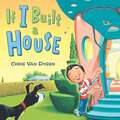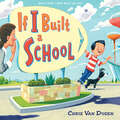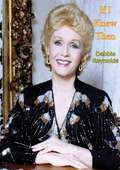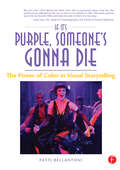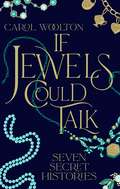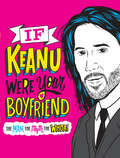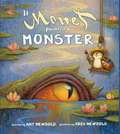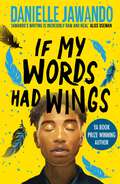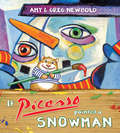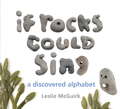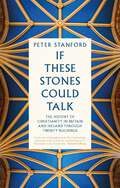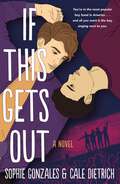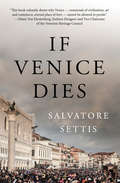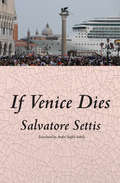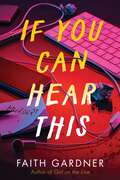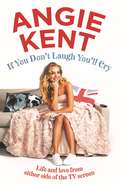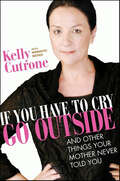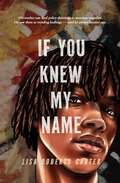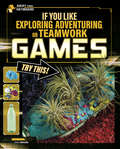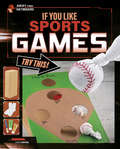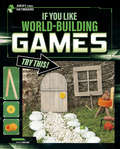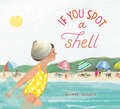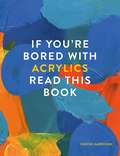- Table View
- List View
If I Built a House (If I Built Series)
by Chris Van DusenThe much-anticipated follow-up to the E. B. White Award-winning picture book If I Built a Car In If I Built a Car, imaginative Jack dreamed up a whimsical fantasy ride that could do just about anything. Now he's back and ready to build the house of his dreams, complete with a racetrack, flying room, and gigantic slide. Jack's limitless creativity and infectious enthusiasm will inspire budding young inventors to imagine their own fantastical designs. Chris Van Dusen's vibrant illustrations marry retro appeal with futuristic style as he, once again, gives readers a delightfully rhyming text that absolutely begs to be read aloud.
If I Built a School (If I Built Series)
by Chris Van DusenIn this exuberant companion to If I Built a Car, a boy fantasizes about his dream school--from classroom to cafeteria to library to playground.My school will amaze you. My school will astound.By far the most fabulous school to be found!Perfectly planned and impeccably clean.On a scale, 1 to 10, it's more like 15!And learning is fun in a place that's fun, too.If Jack built a school, there would be hover desks and pop-up textbooks, skydiving wind tunnels and a trampoline basketball court in the gym, a robo-chef to serve lunch in the cafeteria, field trips to Mars, and a whole lot more. The inventive boy who described his ideal car and house in previous books is dreaming even bigger this time.
If I Knew Then
by Debbie Reynolds Bob ThomasIn If I Knew Then, which was first published in 1962, Debbie Reynolds makes her debut as an author, having already excelled in numerous other fields of expression—including appearing in motion pictures, on the stage, in vaudeville and on television, and selling more than a million copies of her record “Tammy,” from the movie Tammy and the Bachelor (1957).“I’m Debbie Reynolds.“Well, I’m not really Debbie; I’m Mary Frances. But if you like Debbie you can call me that. Or you can call me Sis, like my father, or Frannie, like my brother, or Mrs. Karl or—Whatever you want to call me, I’m pleased to meet you.“Now let’s get down to cases. Like the Case of Why Debbie Reynolds Is Writing a Book. That’s one that even Perry Mason would have trouble solving.“Me write a book?“I can imagine the hubbub this will arouse in certain quarters“People who know me well know I will not be swayed by flattery. I am going to write this book, anyway. First I’d better list what this book is not.“1. It is not an autobiography of Little Me. The life and times of this belle will have to be written a few decades hence.“2. It will not teach you how to play the piano in forty-five (45) days.“3. It will not cure nervous tension, negative thinking or excess acidity.“Then what is it?“It is a book about the things I have learned, often the hard way. It was prompted by the people who have written me for advice on a variety of subjects, mainly personal. Why me, I don’t know. But they write….”—Debbie Reynolds
If It's Purple, Someone's Gonna Die: The Power Of Color In Visual Storytelling
by Patti BellantoniIf it's Purple, Someone's Gonna Die is a must-read book for all film students, film professionals, and others interested in filmmaking. This enlightening book guides filmmakers toward making the right color selections for their films, and helps movie buffs understand why they feel the way they do while watching movies that incorporate certain colors. Guided by her twenty-five years of research on the effects of color on behavior, Bellantoni has grouped more than 60 films under the spheres of influence of six major colors, each of which triggers very specific emotional states. For example, the author explains that films with a dominant red influence have themes and characters that are powerful, lusty, defiant, anxious, angry, or romantic and discusses specific films as examples. She explores each film, describing how, why, and where a color influences emotions, both in the characters on screen and in the audience. Each color section begins with an illustrated Home Page that includes examples, anecdotes, and tips for using or avoiding that particular color.Conversations with the author's colleagues-- including award-winning production designers Henry Bumstead (Unforgiven) and Wynn Thomas (Malcolm X) and renowned cinematographers Roger Deakins (The Shawshank Redemption) and Edward Lachman (Far From Heaven)--reveal how color is often used to communicate what is not said. Bellantoni uses her research and experience to demonstrate how powerful color can be and to increase readers awareness of the colors around us and how they make us feel, act, and react.*Learn how your choice of color can influence an audience's moods, attitudes, reactions, and interpretations of your movie's plot*See your favorite films in a new light as the author points out important uses of color, both instinctive and intentional*Learn how to make good color choices, in your film and in your world.
If Jewels Could Talk
by Carol WooltonA treasure trove of forgotten stories about jewels throughout history by internationally renowned jewellery expert, Carol Woolton. If Jewels Could Talk: Links Through Time delves into the history, cultural significance and eclectic trivia of jewellery. As a jewellery historian, jewellery editor at British Vogue and now podcast host, Carol Woolton is uniquely qualified to take us on a whistlestop tour through history via seven items of jewellery: hoops, rings, beads, charms, brooches, cuffs and head ornaments. Weaving in examples from cultures around the world, Carol will uncover fascinating stories about Viking silver torques, Imperial jade in China, sixteenth-century Posy rings, organic gems, snake motifs, Roman cameo carving, Hindu wedding jewellery, Etruscan gold, Ancient Greek coins, piercings, Wedding pigs in China, tiaras and anklets - to name but a few. A beautiful and illuminating gift for any jewellery lover, If Jewels Could Talk shines a light on all that glitters and more.
If Keanu Were Your Boyfriend: The Man, the Myth, the WHOA!
by Marisa PolanskyImagine dating the internet's boyfriend in this illustrated homage to the always charming and often enigmatic Keanu Reeves. This full-color hardcover contains biographical information as well as illustrated quotes straight from the unicorn-of-a-man himself.Keanu Reeves insists he's "just a normal guy" despite being one of the most recognizable (and most excellent) faces in Hollywood. Apparently, Keanu's humility knows no bounds--just like our love for him. After all, the Keanusance didn't just come out of nowhere. He's had an epic four-decade-long acting career that includes the heart-stopping John Wick, the heart-melting Always Be My Maybe, and the heart-pounding The Matrix. His generosity and kindness are legendary, and he remains an enigmatic mystery we're dying to solve. And how could we forget, he's the Sexiest Man Alive!Part biography and part dreamlike narrative, this vibrant book imagines what it would be like if the internet's boyfriend were YOUR boyfriend. Get to know your man even better through stunning hand-lettered quotes including gems like: "I don't get out much" and "Life is good when you have a good sandwich." If Keanu Were Your Boyfriend is the perfect celebration of the man, the myth, the whoa: Keanu Reeves.
If Monet Painted a Monster
by Amy NewboldA new kid-friendly tour of art history from the inventive Newbolds. Edward Hopper’s monster lurks outside the nighthawks’ diner. James Whistler’s monster rocks in her chair. Monsters invade masterpieces by Dorthea Tanning, Paul Cezanne, M.C. Escher, Jean Michel Basquiat, Giuseppe Archimboldo, Rene Magritte, Henri Rousseau, Franz Kline, Frida Kahlo, Bob Thompson, Henri Toulouse-Lautrec, Thomas Hart Benton, and Helen Frankenthaler. The monster emerging from Claude Monet’s waterlilies is unforgettable. Our guide for this romp through re-imagined masterpieces is an engaging hamster. Thumbnail biographies of the artists identify their iconic works.
If My Words Had Wings
by Danielle JawandoA life affirming story of rehabilitation and hope after prison. The third novel from multi-award-winning Danielle Jawando, perfect for fans of Angie Thomas and Elizabeth Acevedo. &‘Jawando&’s writing is incredibly raw and real; I felt completely immersed&’ Alice Oseman, author of the Heartstopper series When fifteen-year-old Tyrell Forrester gets caught up in a high-profile armed robbery, he's sentenced to eighteen months in a young offenders&’ prison. Now he&’s getting out, and he&’s determined to turn his life around. Despite his release, systemic discrimination makes it difficult for Ty to truly be free. Inspired by a visiting poet while inside, Ty discovers a whole new world through spoken word and is finally finding his voice. But will society ever see him as anything other than a criminal? Praise for And the Stars Were Burning Brightly: 'An outstanding and compassionate debut' Patrice Lawrence, author of Orangeboy 'One of the brightest up and coming stars of the YA world' Alex Wheatle, author of Crongton Knights &‘An utter page turner from a storming new talent. Passionate, committed and shines a ray of light into the darkest places - the YA novel of 2020!&’ Melvin Burgess, author of Junk Praise for When Our Worlds Collided: 'A raw, unflinching and powerful story that will stay with me for a long time&’ Manjeet Mann, author of The Crossing &‘A beautiful ode to found family, and a compassionate look at the power of connection borne from the ashes of tragedy and apathy&’ Christina Hammonds Reed, author of The Black Kids &‘Hard-hitting yet still hopeful, this is an emotional powerhouse of a book&’ Alexandra Sheppard, author of Oh My Gods Warning - this novel contains themes that some readers may find upsetting, including suicide and self harm.
If Picasso Painted a Snowman
by Amy Newbold Greg NewboldMaryland Blue Crab Honor Book 2018 A big, brightly colored, playful introduction to various important painters and art movements. If someone asked you to paint a snowman, you would probably start with three white circles stacked one upon another. Then you would add black dots for eyes, an orange triangle for a nose, and a black dotted smile. But if Picasso painted a snowman… From that simple premise flows this delightful, whimsical, educational picture book that shows how the artist’s imagination can summon magic from a prosaic subject. Greg Newbold’s chameleon-like artistry shows us Roy Lichtenstein’s snow hero saving the day, Georgia O’Keefe’s snowman blooming in the desert, Claude Monet’s snowmen among haystacks, Grant Wood’s American Gothic snowman, Jackson Pollock’s snowman in ten thousand splats, Salvador Dali’s snowmen dripping like melty cheese, and snowmen as they might have been rendered by J. M. W. Turner, Gustav Klimt, Paul Klee, Marc Chagall, Georges Seurat, Pablita Velarde, Piet Mondrian, Sonia Delaunay, Jacob Lawrence, and Vincent van Gogh. Our guide for this tour is a lively hamster who—also chameleon-like—sports a Dali mustache on one spread, a Van Gogh ear bandage on the next. “What would your snowman look like?” the book asks, and then offers a page with a picture frame for a child to fill in. Backmatter thumbnail biographies of the artists complete this highly original tour of the creative imagination that will delight adults as well as children. Fountas & Pinnell Level O
If Rocks Could Sing: A Discovered Alphabet
by Leslie McguirkAmazing rocks, found on a stretch of beach near the author's home, comprise this unique alphabet book. A is for Addition, and there are rocks in the shape of real numbers, too. B is for Bird, and there is a bird rock on a nest with an egg. G is for Ghosts, and there is a host of rocks that look like ghosts! Children and adults alike will pore over these fascinating rocks, and will be inspired collect their own.From the Hardcover edition.
If These Stones Could Talk: The History of Christianity in Britain and Ireland through Twenty Buildings
by Peter Stanford'A heavenly book, elegant and thoughtful. Get one for yourself and one for the church-crawler in your life!' Lucy WorsleyChristianity has been central to the lives of the people of Britain and Ireland for almost 2,000 years. It has given us laws, customs, traditions and our national character. From a persecuted minority in Roman Britannia through the 'golden age' of Anglo-Saxon monasticism, the devastating impact of the Vikings, the alliance of church and state after the Norman Conquest to the turmoil of the Reformation that saw the English monarch replace the Pope and the Puritan Commonwealth that replaced the king, it is a tangled, tumultuous story of faith and achievement, division and bloodshed.In If These Stones Could Talk Peter Stanford journeys through England, Scotland, Wales and Ireland to churches, abbeys, chapels and cathedrals, grand and humble, ruined and thriving, ancient and modern, to chronicle how a religion that began in the Middle East came to define our past and shape our present. In exploring the stories of these buildings that are still so much a part of the landscape, the details of their design, the treasured objects that are housed within them, the people who once stood in their pulpits and those who sat in their pews, he builds century by century the narrative of what Christianity has meant to the nations of the British Isles, how it is reflected in the relationship between rulers and ruled, and the sense it gives about who we are and how we live with each other.'There is no better navigator through the space in which art, culture and spirituality meet than Peter Stanford' Cole Moreton, Independent on Sunday
If These Stones Could Talk: The History of Christianity in Britain and Ireland through Twenty Buildings
by Peter Stanford'A heavenly book, elegant and thoughtful. Get one for yourself and one for the church-crawler in your life!' Lucy WorsleyChristianity has been central to the lives of the people of Britain and Ireland for almost 2,000 years. It has given us laws, customs, traditions and our national character. From a persecuted minority in Roman Britannia through the 'golden age' of Anglo-Saxon monasticism, the devastating impact of the Vikings, the alliance of church and state after the Norman Conquest to the turmoil of the Reformation that saw the English monarch replace the Pope and the Puritan Commonwealth that replaced the king, it is a tangled, tumultuous story of faith and achievement, division and bloodshed.In If These Stones Could Talk Peter Stanford journeys through England, Scotland, Wales and Ireland to churches, abbeys, chapels and cathedrals, grand and humble, ruined and thriving, ancient and modern, to chronicle how a religion that began in the Middle East came to define our past and shape our present. In exploring the stories of these buildings that are still so much a part of the landscape, the details of their design, the treasured objects that are housed within them, the people who once stood in their pulpits and those who sat in their pews, he builds century by century the narrative of what Christianity has meant to the nations of the British Isles, how it is reflected in the relationship between rulers and ruled, and the sense it gives about who we are and how we live with each other.'There is no better navigator through the space in which art, culture and spirituality meet than Peter Stanford' Cole Moreton, Independent on Sunday
If This Gets Out: A Novel
by Cale Dietrich Sophie GonzalesSophie Gonzales and Cale Dietrich's “If This Gets Out is an absolute showstopper! Equal parts edgy and adorable, this bright, joyful book has everything I look for in a queer YA romance.” —Phil Stamper, bestselling author of The Gravity of UsEighteen-year-olds Ruben Montez and Zach Knight are two members of the boy-band Saturday, one of the biggest acts in America. Along with their bandmates, Angel Phan and Jon Braxton, the four are teen heartthrobs in front of the cameras and best friends backstage. But privately, the pressure to stay in the closet has Ruben confiding in Zach.On a whirlwind tour through Europe with an unrelenting schedule and minimal supervision, the two come to rely on each other more and more, and their already close friendship evolves into a romance. But when they decide they’re ready to tell their fans and live freely, Zach and Ruben realize they will never truly have the support they need. How can they hold tight to each other when their whole world is coming apart?
If Venice Dies
by Salvatore SettisIn the tradition of Jane Jacobs’ The Death and Life of Great American Cities comes an urgent plea from internationally renowned art historian Salvatore Settis to preserve Venice’s future.What is Venice worth? To whom does this urban treasure belong? Venetians are increasingly abandoning their hometown — there’s now only one resident for every 140 visitors — and Venice’s fragile fate has become emblematic of the future of historic cities everywhere as it capitulates to tourists and those who profit from them. In If Venice Dies, a fiery blend of history and cultural analysis, internationally renowned art historian Savatore Settis argues that “hit-and-run” visitors are turning landmark urban settings into shopping malls and theme parks. He warns that Western civilization’s prime achievements face impending ruin from mass tourism and global cultural homogenization. This is a passionate plea to secure Venice’s future, written with consummate authority, wide-ranging erudition, and élan.
If Venice Dies
by Salvatore Settis&“This powerful book of cultural criticism&” by the renowned art historian &“shines a harsh light on&” a historic city&’s destruction in the name of profit (The Washington Post). What is Venice worth? To whom do its irreplaceable treasures belong? This eloquent book by art historian Salvatore Settis urgently poses these questions, igniting a new debate about urban stewardship and cultural patrimony at large. As Venice grows increasingly unaffordable and inhospitable to its own residents, Venetians are abandoning their hometown at an alarming rate. At last count, there was only one local for every 140 visitors. As it capitulates to tourists and those who profit from them, Venice&’s transformation into a lifeless shell of itself has become emblematic of the future of historic cities everywhere. In this blend of history and cultural analysis, written with wide-ranging erudition and élan, Settis makes a passionate plea to secure the soul of Venice. &“Anyone interested in learning what is really going on in Venice should read this book.&” —Donna Leon, author of My Venice and Other Essays and Death at La Fenice
If You Can Hear This
by Faith GardnerThe twisty, intricate mystery of I Killed Zoe Spanos meets the whip-smart sleuthing of A Good Girl’s Guide to Murder in the newest novel from acclaimed author Faith Gardner, in which a club of misfits must come together to solve a dangerous mystery—and learn to lean on each other all the while.Posey Spade loves asking questions—it’s what’s going to make her a fantastic journalist someday. And ever since her best friend and crush chose someone else, Posey’s only focusing on her future career.Unfortunately, she’s just moved to the small town of Wild Pines—which doesn’t provide a lot of groundbreaking journalism opportunities, only a scrappy AV Club full of self-proclaimed slackers . . . who Posey must somehow inspire to greatness.She never thought that inspiration would come from the disappearance of the club’s beloved sponsor and teacher, Ms. Moses. But as the days tick by with no answers, Posey and the AV Club take it upon themselves to dig into the mystery.From a nepotism scandal to a local cult, Posey learns a lot about her new town. And as she spends more time with the AV Club, she also learns that friendship is just as necessary to solving a mystery as lots of questions. Good thing Posey has both.
If You Don't Laugh You'll Cry: Life and love from either side of the TV screen
by Angie KentAngie Kent won hearts and friends when she partnered with best friend Yvie Jones to commentate from the couch as we watched them watching TV on Gogglebox. Then Angie proved a stalwart on the 2019 season of I'm a Celebrity ... Get Me Out of Here! And THEN she became the unforgettable 2019 Bachelorette. It's clear Australia can't get enough of Angie - and now she gives us some of her quirky, funny, warm-hearted wisdom on life, love and everything in between, in the form of a book.With no holds barred - just as you'd expect - Angie talks about her challenges with mental health and body image; her family and friends; what has and hasn't worked in her relationships, and what she has learned - the hard way - about life. There are plenty of laughs, and some tears, and always plenty of heart. Angie's is the voice of your imaginary best friend - the one who always has your back, and who knows just what to say because she's been there before.
If You Have to Cry, Go Outside: And Other Things Your Mother Never Told You
by Meredith Bryan Kelly Cutrone“Full of anecdotes, personal and professional life as well as motivational tips,” the New York Times–bestselling memoir from the candid tv personality (People.com).Media maven Kelly Cutrone spills her secrets for success without selling out. She combines personal and professional stories from her high-profile gigs as Whitney Port and Lauren Conrad’s boss on The Hills, star of Bravo's Kell on Earth, judge on America’s Next Top Model, and CEO/founder of the fashion PR firm People’s Revolution to offer young professional women no-nonsense, brutally honest career advice—and other things their mothers never told them.“[Cutrone’s] hellish take on the fashion world is her ticket to stardom. . . . reads as a gritty guide for young women entering the fashion world.” —USA Today“Choice career and style advice from New York’s most outspoken PR woman.” —WSJ.com“What everyone loves about Kelly Cutrone . . . is that she isn’t afraid to tell it how it is.” —Elle Magazine“Cutrone gives blunt, how-to advice on how to be a “power bitch” . . . It’s an old-fashioned guide to succeeding in both life and work . . . with a dash of self-styled spirituality and, of course, all dressed up in Balenciaga.” —New York Post “Part memoir, part self-improvement sermon . . . it recounts Cutrone’s own fitful journey.” —New York Magazine “The book outlines [Cutrone’s] tumultuous rise from homelessness to the fashion elite and serves as a guide for navigating an alternative career path.” —The Harvard Crimson“A raw, no bullshit, . . . autobiographical joy ride that preaches spiritual self-empowerment over self-sabotage.” —Out Magazine“A message of girl power . . . entertaining for all.” —Los Angeles Times
If You Knew My Name: A Novel in Verse
by Lisa Roberts CarterLisa Roberts Carter&’s debut, If You Knew My Name, is a novel-in-verse telling the story of 17-year-old Mason Tyndall— an aspiring rap artist whose mother is a BLM activist. She saw fatal officer-involved shootings as senseless tragedies. He viewed them as trending hashtags — that is, until he almost became one.Mason Zy&’Aire Tyndall has big dreams. Dreams of sick beats, epic mic-drops, sold out stadiums. Mason&’s going to be a rap star—and you don&’t become a rap star by hitting up BLM protests with your mom or sitting at a desk. Mason wants to get out there and make a name for himself, but he&’ll have to graduate high school first. And he can&’t do that if he fails his senior year. Convinced his poetry class is a waste of time, Mason&’s teacher helps him see just how valuable a couplet and a rhyme can be. But when an unarmed Black man is killed by the police in his city, tensions start to rise—among the cops, the community, and even Mason&’s peers. Caught in the middle of increasingly violent conflicts, Mason will have to find a way to use his voice for change…and fast.
If You Like Exploring, Adventuring, or Teamwork Games, Try This! (Away From Keyboard)
by Daniel MauleónEven the most game-crazed kids need a tech timeout. No cheat codes needed for this collection of DIY projects! Not enough controllers for the whole crew? No problem! Bring adventure and teamwork games to life with these activities.
If You Like Sports Games, Try This! (Away From Keyboard)
by Marne VenturaEven the most game-crazed kids need a tech timeout. No cheat codes needed for this collection of DIY projects! From baseball and football to racecars and obstacle courses, these activities bring sport games to life.
If You Like World-Building Games, Try This! (Away From Keyboard)
by Marne VenturaEven the most game-crazed kids need a tech timeout. No cheat codes needed for this collection of DIY projects! Bring world-building games to life with miniature medieval towns, sweet castles, pixel pillows, and more!
If You Spot a Shell (If You Find a Treasure Series)
by Aimée SicuroA stunning companion to If You Find a Leaf, this cheery picture book captures the excitement of summer and encourages children to see their collected seashells in an entirely new way. The artist incorporates real shells into her exquisite illustrations.A warm summer breeze and the gentle waves of the ocean wash ashore many different types of shells. In this story a girl collects shells and thinks of all the magnificent things they can be turned into with a little creativity. She imagines one shell as a swimming cap for diving into the crashing waves, another as a magical kaleidoscope, one as a rocket ship to take her way up high and another as a submarine for exploring the wonders of the world below. The girl draws inspiration from the unique beauty of each and every shell.In this joyous celebration of a day at the beach, artist Aimee Sicuro uses real shells she&’s hand selected to make her oh-so-charming illustrations. Any young reader who turns the pages of this beautiful book will be inspired to use their own imagination as they comb the beach for shells this summer.
If You're Bored With Acrylics, Read This Book (If You're ... Read This Book Ser.)
by Denise HarrisonUnlock the potential in your paint tubes with 30 guided projects, covering everything from creating a harmonious colour palette to painting vivid landscapes and pop-art portraits. Get back to basics and explore the possibilities of colour, mark-making, textures, tools and techniques, or push the boundaries of acrylics by altering the qualities of the paint. This book will challenge your preconceptions about acrylics, and encourage you to return to the medium with fresh eyes and new ideas.
If You're Bored With Acrylics, Read This Book (If you're ... Read This Book #4)
by Denise HarrisonUnlock the potential in your paint tubes with 30 guided projects, covering everything from creating a harmonious colour palette to painting vivid landscapes and pop-art portraits. Get back to basics and explore the possibilities of colour, mark-making, textures, tools and techniques, or push the boundaries of acrylics by altering the qualities of the paint. This book will challenge your preconceptions about acrylics, and encourage you to return to the medium with fresh eyes and new ideas.
